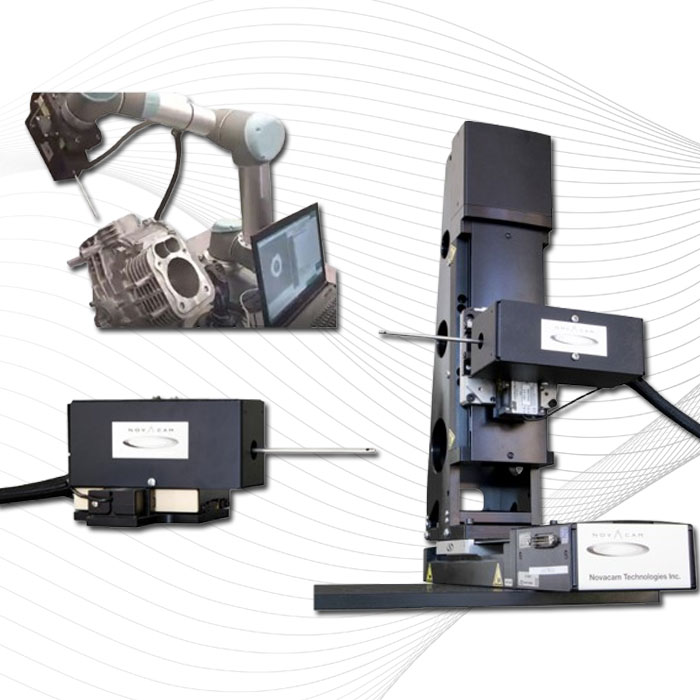Boreinspect
- Home
- Industry
- Boreinspect
Boreinspect™ system
for 3D bore measurement
NOVACAMTM BOREINSPECTTM system is a modular, non-contact optical bore measurement system that provides micron-precision 3D measurements of bore interiors and other hard-to-reach spaces. Its rotational scanner probe easily enters tight spaces to acquire their complete inside geometry at high speed. The BOREINSPECT system:
Micron-precision 3D measurements
- Measures inside diameter (ID) features such as undercuts, chamfers, threads, rifling, O-ring grooves, splines, lands, and edge breaks
- Enables fully configurable automated bore measurement
- Produces 3D point cloud data for calculating GD&T parameters
- Can measure dimensional or surface defects such as porosities, cracks, burrs, or scratches
- Can measure roughness as well as thickness of semi-transparent coatings
Overview of features and benefits
Bore measurements
- Optical, non-contact, non-destructive
- High speed: Up to 100,000 3D point measurements per second
- 3D inside diameter (ID) measurements: diameter, circularity, cylindricity, runout, taper, distortion, straightness
- 2D and 3D surface and subsurface characterization
- High-aspect-ratio features: undercuts, threads, O-ring grooves, cross-holes
- Micron resolution and excellent sensitivity and measurement repeatability
Imaging options
- Line profiles
- 3D visualization for interactive analysis of bore measurements
- Height and intensity images of “unfolded” surfaces
- Cross-sections of semi-transparent materials
- Deviation maps
Benefits
- Bore measurement system that is easily integrated in lab, shop, or fully-automated industrial inspection setups
- Reduces cycle time of bore measurement: the rotational scanner spins the probe at up to 30 rotations per second, and obtains up to 100,000 3D measurements per second. Each measurement represents a 3D topographic point.
- Flexible options for evaluating inspected partsmeasured features can be compared to CAD drawings or to a user-defined set of locations, nominals, and tolerances
- Simple scan definition and execution: Define the scan sequence once by teaching the system with a joystick. The scan definition can later be executed with the push of a button.
- Time-saving automated reporting: Following a scan, go-no-go bore measurement reports can be produced and results logged in a manner compatible with industry-standard mechanisms.
- Adaptable to harsh environments
- No consumables are needed: Optical probes do not come in contact with the measured surfaces, and therefore do not wear out like contact probes. Accidental damage is rare-probes are designed to be rugged.
Metrology Applications
3D bores measurements for industry and R&D
- Quality control
- Automated 3D production inspection, geometric dimensioning and tolerancing (GD&T)
- Statistical process control (SPC)
- Research and development (R&D) inspection
- Reverse engineering and part-to-CAD
- Maintenance, repair and operations (MRO)
- Profilometry in harsh environments
Typical bore measurements
- Full ID geometry: GD&T : diameter, circularity, cylindricity, taper, runout, straightness, etc.
- Deviation from CAD model
- High-aspect-ratio features: steps, O-ring grooves, undercuts, threads, channels, sharp edges, steep slopes, and cross-holes
- Volume loss: surface wear or other damage
- Defects: corrosion, pitting, cracking, denting, scratching, porosity
Examples of bore measurement applications
Measurement, visualization, and GD&T inspection of ID surfaces in:
- Parts made by casting, high-precision drilling, deep gun drilling, injection molding, 3D printing, additive manufacturing
- Extrusion dies, feed-through holes, conical bores, blind bores
- Automotive industry engine components: valve body bores, valve seats, cylinder blocks, cylinder heads, camshafts, crankshafts, drive shafts, combustion chambers, die cast parts, and more
- Aerospace industry: rivet holes and countersinks in aircraft fuselage assembly, valve bores, cylinder bores, manifolds, and other engine components featuring bores, slots, or other hard-to-reach spaces
- Aerospace and industrial gas turbine engines: compressor and turbine airfoils and vanes, vane rings, duct or nozzle throats, shafts
- High-precision machining: bores, barrels, tubes and slots in parts for defence, industrial, medical equipment, nuclear, oil and gas, power generation, transportation (train and marine as well as aerospace and automotive) sectors
System Software
The BOREINSPECT system comes with NOVACAM high-performance data acquisition software-which is PC Windows®-based and user-friendly for scan programming.
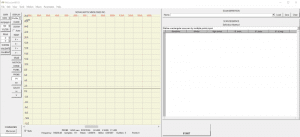
The system simultaneously generates 3 data sets from the same scan:, 3D point cloud, light intensity image, and height image. The height and light intensity images facilitate defect detection. STL file format is also available
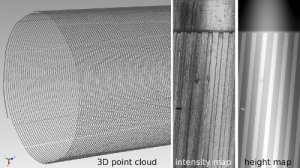
For full GD&T analysis of measured parts, a turnkey solution is available with PolyWorks InspectorTM, metrology software that may be purchased with the system.
- Go-no-go reporting is easily programmed and automated.
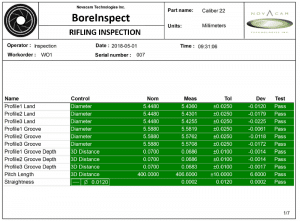
- Users benefit from capabilities such as a quick visual comparison (deviation map) of the acquired part measurements to pre-specified tolerances or to the CAD of the part.
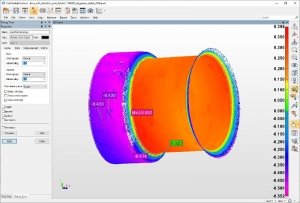
Visualizing the scan data may be accomplished by importing the data into various third party visualization and numerical analysis software, such as PolyWorks Inspector, Geomagic, ImageJ, SolidWorks, Octave, MatLab, Mathematica, IDL, or IGOR Pro
Deriving application-specific measurements from the 3D point cloud is available through a selection of in-house and third party software. Novacam supports the following options:
Standard system configuration
A standard configuration of the BOREINSPECTTM system includes:
- RS2 rotational scanner with a standard 4.6 mm-diameter side-looking probe (for inspection of bores up to 660 mm (26″) deep)
- MICROCAM-3D profilometer
- 3-axis inspection station and 3-axis motion controller
- PC with NOVACAM acquisition software
- 1 year warranty
Instrument safety
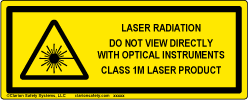
- MICROCAM-3D/4D systems feature an in-probe red laser pointer (650 nm wavelength) for alignment purposes.
- MICROCAM-3D/4D systems are Class 1M Laser products, with < 20 mW of infrared and < 5 mW of in-probe laser pointer.
BOREINSPECT system in the news
- “3D imaging enables high-speed bore inspection” (Vision Systems Design magazine, January 25, 2018)
- “3D imaging technology inspects hard-to-reach spaces”(Vision Systems Design magazine, January 16, 2018)
- “Automated Rivet Hole Inspection and 3D Measurement”(Metrology news, March 13, 2020)
Frequently asked questions
How long does it take to measure a bore?- Scan time depends on the bore size, bore length, and what aspects of the bore you need to measure. The scanner rotates at 1,800 rotations per minute (or 30 rotations/second) and the BOREINSPECT system (with MICROCAM-4D interferometer) acquires 100,000 3D measurements per second, or roughly 1 million 3D topography points in 10 seconds. The user selects the rotation and acquisition speeds and the pitch of the spiral, which together determine the number of points that will be acquired and the time the scan will take. In general, dimensional measurement (for GD&T) require the least amount of points and can be achieved the fastest. Roughness callouts may take 3 to 4 seconds each. Defect detection requires the most amount of points, of course depending on the size of defect you are looking for. For help on estimating the time required to scan your sample, please contact us.
- Yes. The scanning sequence (recipe) can be programmed with a joystick and can be recalled at later times with the push of a button. See our how-to video on how to measure bore ID dimensions
- Yes. Both inline and robot setups are possible.
- Yes.
- No, runout is not an issue. Gauge rings are used to calibrate the probe and validate the results. The system provides micron-level diameter measurement repeatability.
- The BOREINSPECT RS probe should be positioned close to the centerline of the bore (within a mm) to capture the entirety of the features. For irregularly-shaped objects or slots or crevices, the RS probe can acquire the entire surface by scanning from several positions.

